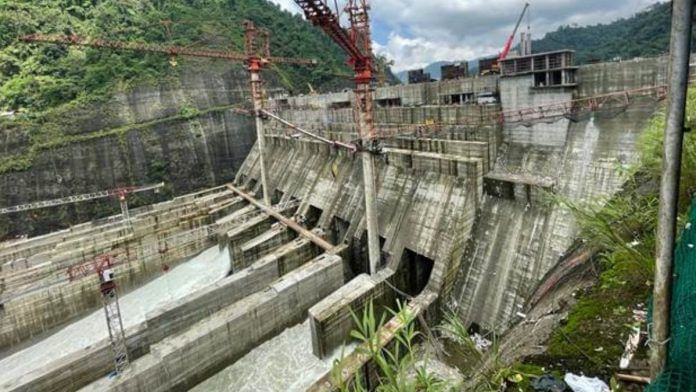New Delhi: India’s energy security in the Northeast is poised for a significant boost.
The State-owned National Hydroelectric Power Corporation (NHPC) has initiated the commissioning process for one 250-MegaWatt (MW) unit of the Subansiri Lower Hydroelectric Project near North Lakhimpur, on the Arunachal Pradesh-Assam border, senior NHPC officials told ThePrint.
This move marks a crucial milestone for the long-delayed project under NHPC, the country’s largest hydroelectric power developer.
The run-of-the-river project on the Subansiri, a tributary of the Brahmaputra, will eventually have eight units with an installed capacity of 2,000 MW and will be one of the largest hydropower project once completed mid next year.
The project has faced massive delays due to protests by local communities against it, as well as environmental factors, including landslides. The delays have resulted in the project cost escalating from Rs 6,285 crore in 2002 to Rs 26,075 crore now.
However, this latest boost in India’s hydropower sector is especially significant given China’s construction of the world’s largest hydropower project on the Brahmaputra in Tibet, where the river is known as the Yarlung Tsangpo.
The proposed 11,200-MW Upper Siang multipurpose project in Arunachal Pradesh is intended to be a counter to China’s mega dam. But it continues to be stalled due to strong local opposition.
“The wet commissioning of one 250-MW unit of the Subansiri project has begun—along with its synchronisation with the national grid. Further tests are in process for the full commissioning of Unit 1. And subsequently, there will be commissioning of three other units, which will be ready in phases,” a senior NHPC official, who did not want to be named, told ThePrint.
The commercial operationalisation of all four units—one after another—will likely be completed from the end of November to 31 December 2026.
The Subansiri hydropower project was originally slated for completion in 2014.
Operational clearances
“With the successful wet commissioning of Unit 1, synchronisation with the national grid begins; soon to be followed by three more 250-MW units—adding 1,000-MW this year,” the NHPC posted on X Friday, marking the landmark moment.
“On completion, the Subansiri Lower HEP (8×250 MW) will stand as India’s largest hydroelectric powerhouse, lighting millions of homes and driving the nation’s energy security and sustainable progress,” the post added.
Four units of the Subansiri hydropower project will start commercial operations by December, while the remaining four—already in advanced stages of construction—are projected to be ready by May 2026.
National Dam Safety Authority (NDSA) chairman Anil Jain has confirmed the clearances to the Subansiri project’s four units with ThePrint.
In April 2025, the NDSA formed an expert committee after the NHPC requested permission for filling the reservoir for the first time.
The committee members visited the project site three times and suggested upgradation works to the NHPC to ensure dam safety.
“The NHPC complied with the recommendations, following which it received the clearance by the dam safety authority for initial filling last month,” Jain added.
An NDSA clearance is mandatory for any dam built by a central PSU before commercial operationalisation.
Also Read: Rajya Sabha passes Dam Safety Bill, which took 34 years to draft. Here’s why it is important
Mired in delays from ‘go’
The Subansiri project has been passing through challenging phases since its inception.
From massive local agitation to frequent landslides that halted work, the project suffered delays resulting in a significant cost escalation.
The techno-economic clearance of the project was obtained in September 2003. This means that the construction of a 125-metre-high concretised gravity dam, as well as a surface power house of eight units of 250 MW each, has been cleared.
The dam construction began in 2008 but paused in December 2011, following fierce local protests against the project.
While the agitation was going on, a petition was filed in the National Green Tribunal (NGT) in 2015 against the construction. The NGT case continued until 2019.
In between, various technical committees set up by the Union Ministry of Power reviewed the project. While the technical review committee set up in 2012 submitted its report in 2013, the dam design review panel and the project oversight committee reports were submitted in 2014 and 2016, respectively.
Additionally, an NGT-constituted expert committee, in its report submitted in 2019, directed the resumption of work, which eventually began again in November 2019.
However, soon after, a natural disaster struck.
In June 2020, a landslide near the project site cut off the access road to the dam.
Landslides again disrupted building work in 2021, 2022, and 2023. Work finally picked up pace in 2024.
Other Brahmaputra dams
India is constructing over half a dozen hydro power projects to harness power from the Brahmaputra in Arunachal Pradesh. Of these, the largest—11,200 MW Siang multipurose project—is mired in delays due to local opposition.
Besides the 2,000-MW Subansiri hydropower project, NHPC will construct a 1,650-MW hydropower project in Upper Subansiri.
A second 2,880-MW multipurpose project is under construction on the River Dibang in the lower Dibang valley.
The construction of another 1,800-MW hydropower project on the River Kamala—a tributary of the Subansiri—in the Kamle district of Arunachal Pradesh, is also underway.
Two other projects—the 186-MW Tato-I and 240-MW Heo hydropower projects—were approved by the Union cabinet last November.
(Edited by Madhurita Goswami)
Also Read: Shift focus from dams, what India needs is better water management: Top water conservationist






